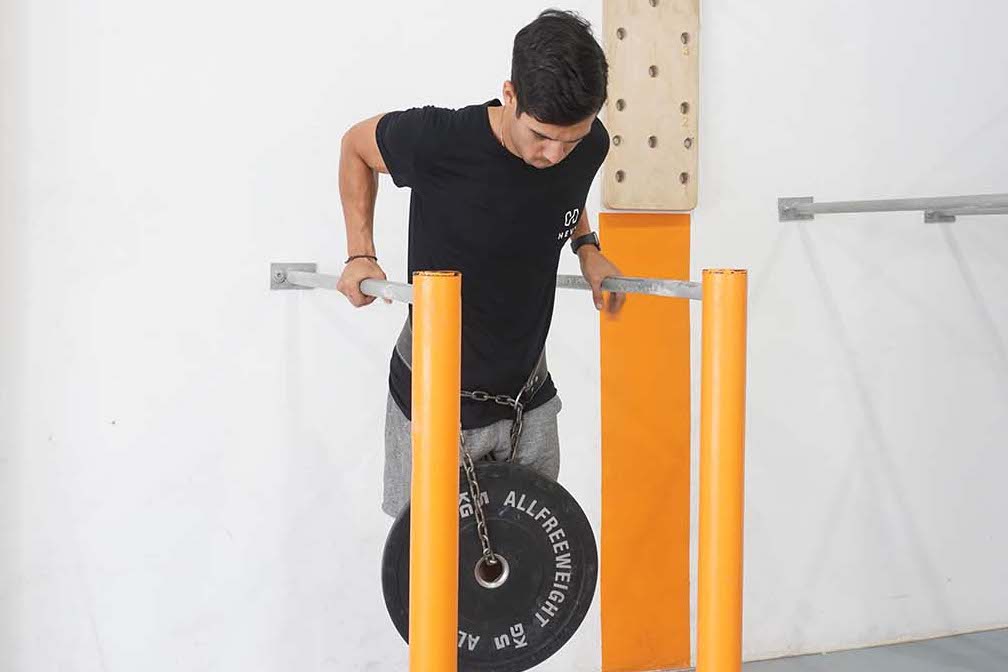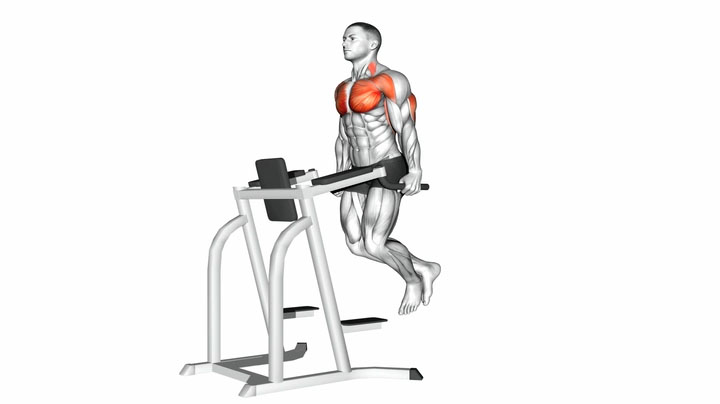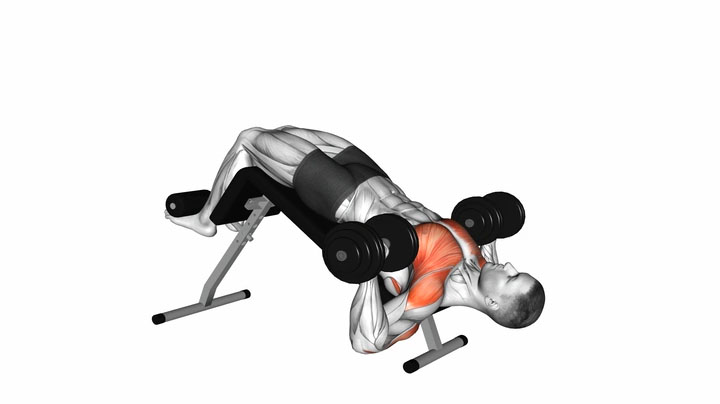The Benefits of Weighted Dips
Weighted dips are a challenging exercise that strengthens the chest, shoulders, triceps, serratus anterior, and entire core. Like bodyweight dips, you perform the movement by grabbing a pair of parallel bars, suspending yourself in the air, descending by bending your elbows, and pressing yourself up.
The difference is that you attach an external weight by using a special belt, wearing a weight vest, or holding a dumbbell between your feet.
A notable benefit of weighted dips is the progressive overload. While bodyweight dips might seem challenging initially, most trainees reach a point where they have to perform 30, 40, or even 50 reps to challenge themselves. Adding external weights allows you to stay within a specific repetition range and get stronger.
Another benefit of weighted dips is that you develop your lower chest. You must press down and forward during chest dips, placing your lower chest at a mechanical advantage and causing superior activation in the area.
The third benefit of weighted dips is improved shoulder stability, making you stronger, more athletic, and less likely to get injured. Your shoulder muscles play a considerable role during dips because they must keep the relatively unstable shoulder joint in position.
We recommend including weighted dips early in your training. The movement is highly technical, and performing it while you’re fresh will reduce the risk of poor technique. Start with no more than 10 lbs of extra weight to gain confidence with the exercise, and avoid overloading yourself to the point where you cannot do more than three to five reps per set.
Level of Exercise: Intermediate/Advanced
How to do a Weighted Dip

- Attach a weight plate to yourself via a special belt or put on a weight vest.
- Step on the platform and grab the parallel bars while keeping your arms straight and close to your body. Alternatively, grab the bars and jump as you engage your triceps to get to the top if your dip stand doesn’t have footplates.
- Bring your shoulders back and down, engage your abs, squeeze your glutes, and take a breath.
- Take your feet off the platform to suspend yourself in the air and support yourself through your upper body musculature.
- Lean forward slightly to put your pectoralis major in a better position to work during the exercise.
- Take another breath and lower yourself (dip) by bending your elbows. Keep your shoulder blades retracted and your body in a stable position.
- Move down until your elbows form a 90-degree angle and hold the bottom position for a moment. Alternatively, descend slightly less if going all the way down leads to shoulder discomfort.
- Contract your triceps and pectorals to press yourself back to the top, extending your arms fully. Exhale near the top.
- Take another breath and repeat.
Once finished, bring yourself to the top, place your feet over the footplates, and let go of the bars. Alternatively, get to the top and let go of the bars to land on the floor. Be careful with the second approach because the weight plate might hit your groin.
What muscles do weighted dips activate?
The primary muscle group that works during weighted dips is the pectoralis major, which covers the upper front side of the torso. Our pecs are large, fan-shaped muscles that originate from several points, including the sternum, and narrow down to the point that attaches to the humerus (upper arm bone) (1).
The muscle group plays an essential role in numerous arm motions and works hard during dips, allowing us to descend slowly and move back up.
Our triceps are the second major muscle group that works during a weighted dip. The muscle group makes up the rear of our upper arms, and its primary function is elbow extension (straightening of the arm) (2). Our triceps produce force as we descend but become more active as we move up, with activation peaking near the top of each repetition.
The shoulders (deltoids) are the third muscle group with an essential role during weighted dips. First, the muscle group flexes isometrically to stabilize the shoulder joint, allowing us to maintain our balance and do more repetitions. Second, the anterior deltoid head assists the pectoralis major and triceps during the descent and as we press ourselves to the top position.
Our serratus anterior muscle also works during triceps dips. The muscle originates from the ribcage and inserts into the scapula (3). It plays an important role in scapular stability and assists the active muscles during a weighted dip.
Aside from the active muscles, our entire core flexes isometrically to provide torso and hip stability, leading to good balance and safety. Among the involved muscles, we have the gluteus maximus, rectus abdominis, internal and external obliques, and more.
Similarly, the upper back musculature contracts to keep our shoulder blades retracted and in position, reducing the risk of the shoulders shrugging up during dips.
Chest Dips Vs. Bench Press
People often compare weighted dips with the bench press, trying to understand the two moments and which one might be better. The truth is that both exercises offer unique benefits, and neither is necessarily ‘better’ than the other. What matters most is that you enjoy the movements, perform them safely, and feel the correct muscles working during each repetition.
For instance, the bench press is an excellent compound movement that develops the chest, shoulders, and triceps. Doing the bench press correctly and with the right load builds your upper body strength and musculature. Unfortunately, not everyone does the exercise correctly, leading to poor muscle activation and a higher injury risk.
The weighted dip is also a great exercise, but its effectiveness depends on proper execution. Attaching a lot of weight to yourself and doing half-reps makes the movement less effective and more dangerous.
The bench press and weighted dips have similar safety ratings, but mastering the latter will likely take longer. It’s relatively common to see trainees pressing a lot of weight, but not many people can perform the weighted dip correctly. In any case, it’s best to start with a low load, practice each exercise, and increase the resistance once you’re confident in your technique.
Practically speaking, the bench press doesn’t emphasize your lower chest that well, which means you can combine it with a weighted dip for more balanced pectoral development.
A notable benefit of both movements is their fantastic overloading potential. Dips and bench presses allow you to train with a lot of weight to cause the necessary mechanical tension for muscle and strength gain (4). You can also do the two movements inside the same session or training week. For instance, perform dips with more weight for fewer reps and bench press a lighter load for more repetitions.
Variations and Modifications of Weighted Dips
1. Bodyweight Chest Dip

Bodyweight chest dips are a variation everyone should master before attempting weighted dips. The two movements are identical in many ways, and the primary difference is that one includes external resistance, whereas the other leverages only your body weight. Learning how to do the exercise by leveraging only your body weight is crucial for activating the correct muscles and staying safe in the long run.
2. Weighted Triceps Dip
The primary difference between chest and triceps dips is your torso position. During chest dips, you must lean forward and remain more upright for triceps dips. Weighted triceps dips are an excellent compound exercise that overloads your triceps, similar to the close-grip bench press.
3. Assisted Dips
Assisted dips are a beginner-friendly variation you perform on a special gym machine. Similar to a dip stand, you must grab a pair of parallel bars to perform the exercise, but the machine features a padded platform for your knees. You can adjust the level of assistance you get from the machine to develop your dip strength gradually and improve your form.
Mistakes to Avoid
Shortening The Range of Motion
One of the most common errors with the dip is shortening the range of motion. Trainees often bring themselves to the top position but fail to descend enough to stretch the involved muscles. Doing so makes no sense because you’re attaching a weight to yourself to make the exercise more difficult but are training through a shorter range of motion to make dips easier. If you don’t have the strength to perform weighted dips effectively, remove the load and master proper form with bodyweight dips.
Not Keeping Your Shoulders Retracted
The second common error with weighted dips is not retracting your shoulder blades, which creates a few issues. First, your shoulders are in a weaker and compromised position, increasing the risk of an injury. Second, you cannot engage your pectoralis major as effectively, making it impossible to perform well. Third, you’re more unstable, and your shoulders are more likely to shrug up (elevate) as you descend, making the exercise unnecessarily difficult.
Avoid the error by bringing your shoulder blades back and keeping them in position throughout each set. If you cannot do that, remove the external load and focus on building up your upper back strength.
Losing Your Balance
The third error to watch out for when doing dips is losing your balance. Trainees often wobble as they get to the bottom or top position, leading to instability. Avoid the mistake by keeping your entire upper body tense and performing repetitions more slowly.
Similar Exercises to the Weighted Chest Dip
Push Up (Weighted)

Weighted push-ups are similar to chest dips because they are bodyweight movements you make more challenging by adding resistance. Dips and push-ups have similar ranges of motion, and you’re training the same muscles (5).
The primary difference between the two is that push-ups are more challenging to load because your main option is to place a weight plate on your back, which often requires assistance from a gym buddy. In contrast, dips are more suited for overload because you can attach weight plates via a special belt.
Decline Bench Press (Dumbbell)

The decline dumbbell bench press is an effective compound exercise that strengthens your chest, shoulders, triceps, and core. Like weighted dips, the decline press emphasizes the lower chest, contributing to the more balanced development of the muscle group. Another similarity is that both movements offer a fantastic overloading potential, and you can use the decline press and weighted dips to develop your upper body musculature.
Cable Fly Crossover
The cable fly crossover is an isolation movement that develops the chest. Having the pulleys in a high position and pulling the cables down and in emphasizes your lower chest, similar to a dip. The primary difference is that flys work around one joint (the shoulder), and you must use a lighter weight for more repetitions.



